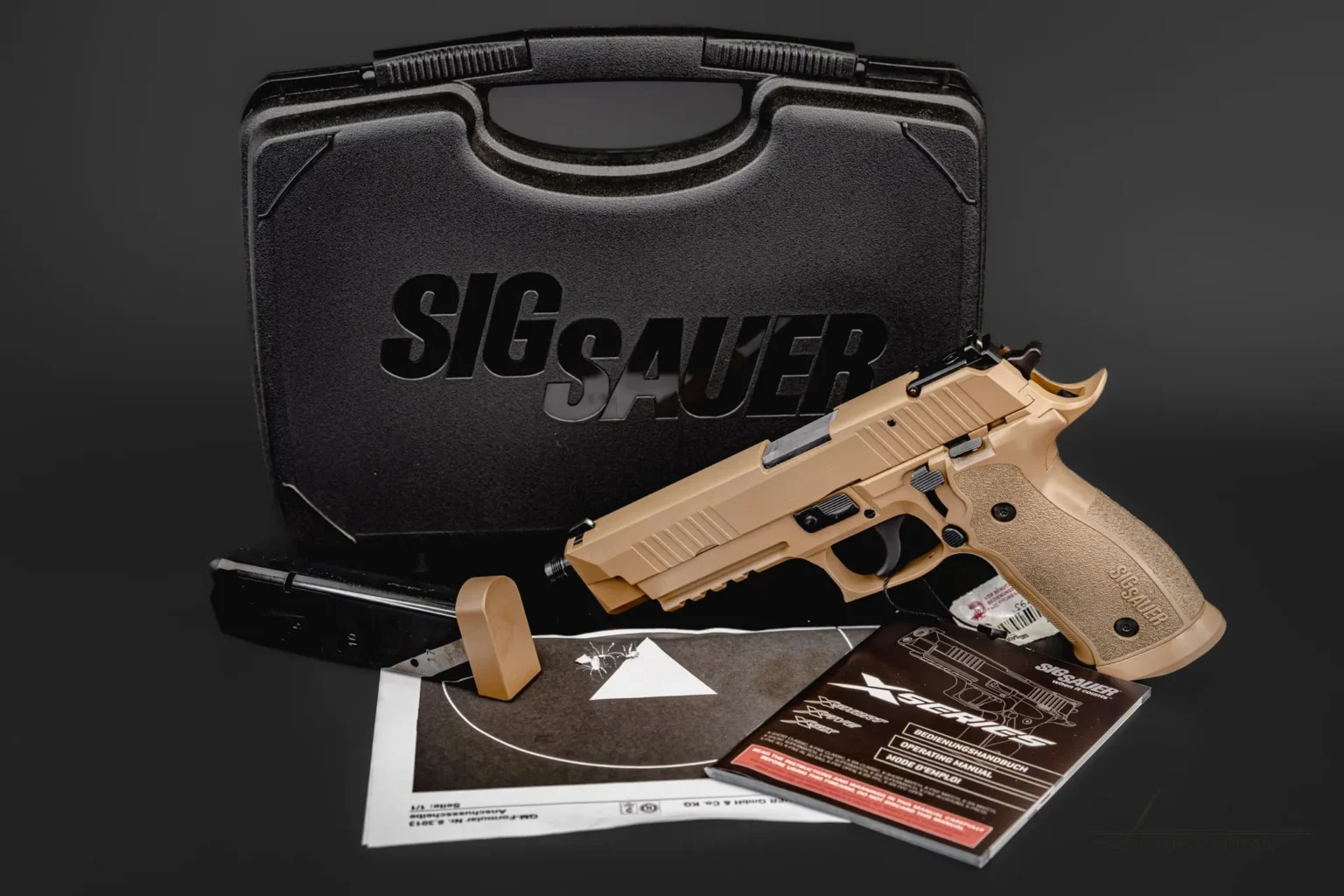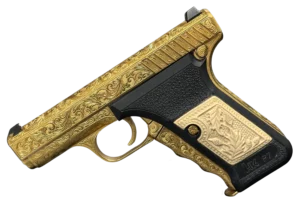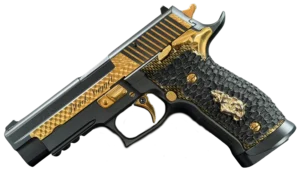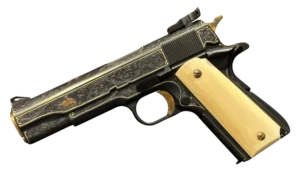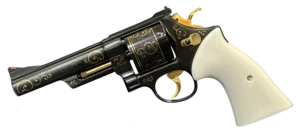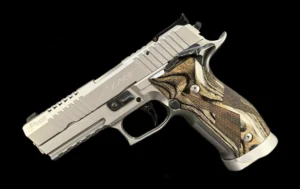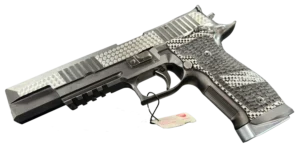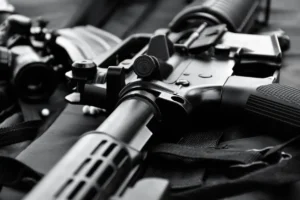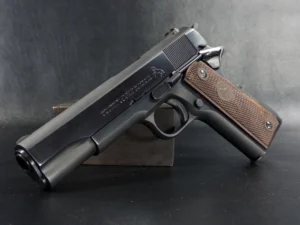Key Takeaways:
- The P226 earned its stripes in the real world, not just in spec sheets: Originally designed for the military, the SIG Sauer P226 didn’t win the XM9 contract — but that didn’t stop elite units like the Navy SEALs from picking it anyway. Why? Because when it came to reliability, accuracy, and pure build quality, it just worked.
- It’s got range — literally and figuratively: Whether you’re into competition shooting, need a dependable duty weapon, or just want something you can trust for home defense, the P226 adapts. With models like the X-Five, Legion, and M11-A1, plus multiple calibers and loads of customization options, there’s a version for pretty much everyone.
- It’s not trendy. It’s timeless: In a world full of flashy new polymer pistols, the P226 is still out there doing its thing — reliably, consistently, and without compromise. It’s not trying to be the latest craze. It’s just built to last, and weirdly enough, that’s become its own kind of cool.
There’s something about the SIG Sauer P226 that just… sticks with you. Maybe it’s the way it balances in the hand, perhaps it’s the history, or maybe it’s because once you’ve fired one, you kinda get why so many professionals won’t trust anything else. Whatever it is, this full-sized, all-business handgun has carved out a reputation over the last few decades that’s tough to beat.
Initially designed for military use — yep, it was SIG’s contender for the U.S. military’s XM9 trials in the 1980s — the P226 didn’t land the contract, but it still ended up in the hands of some of the most elite forces in the world. And here’s the kicker: it wasn’t just “good enough.” It was better. That trial might’ve gone another way on paper, but in the real world? The P226 found its people — Navy SEALs, federal agencies, competitive shooters, and serious civilians. The kind of folks who need their gear to work, no matter what.
So, let’s unpack what makes the P226 such a beloved workhorse — and why, decades later, it still deserves a spot in any serious shooter’s lineup.
A Bit of History (It’s Not Boring, Promise)
In the early 1980s, the U.S. military was seeking a new sidearm. SIG Sauer threw its hat in the ring with the P226 — a beefed-up version of its already solid P220, but with higher capacity and some clever tweaks. Beretta ultimately won the contract (hello, M9), but SIG’s gun impressed the right people. The SEALs, for one, weren’t thrilled with the M9’s performance and went with the P226 instead.
That move helped cement the gun’s legendary status. Over time, it became a favorite not just for special forces but for law enforcement across the globe. And while other guns have come and gone, the P226 has stuck around, essentially unchanged in its core DNA. Because when something works, why mess with it?
Ergonomics: Like a Glove, but German-Swiss
Let’s talk feel — because a gun can shoot great, but if it doesn’t sit right in your hands, what’s the point?
The P226 is built on an aluminum alloy frame, which keeps it lighter than it looks. It’s not a featherweight, but it’s balanced. Solid. Purposeful. Like you’re holding a real machine, not a toy.
SIG nailed the ergonomics early on, but they didn’t stop there. Over the years, they’ve rolled out features like the E2 grip — designed for individuals with smaller hands — and a smart beavertail extension that allows you to ride high on the grip for improved control. Ambi shooters aren’t left out either: the reversible mag release is a welcome touch.
Toss in forward slide serrations, a MIL-STD-1913 rail, and a simple, intuitive layout, and you’ve got a pistol that’s just… easy to work with. No fighting it, no adjusting your grip mid-string. It’s there to help you shoot better, not get in the way.
Trigger Time: Smooth, Predictable, and Addicting
If you’ve never shot a SIG DA/SA trigger, you’re in for a treat.
Out of the box, the standard double-action/single-action system offers a long but smooth first pull, followed by a crisp single-action follow-up. It’s like training wheels for precision — once you get that first shot off, the gun just flows.
But it gets better. SIG’s Short Reset Trigger (SRT) option cuts down the distance between shots, making follow-ups quick and satisfying. Prefer consistency over variety? There’s also a Single Action Only (SAO) version for the competition crowd. No surprises — just a clean break every time.
And here’s something not enough people talk about: the decocker. It lets you safely drop the hammer on a loaded chamber without firing. That’s not just convenient — it’s peace of mind.
Reliability: It Just Doesn’t Quit
Look, every brand claims their gun is reliable. But the P226 has decades of real-world proof to back it up.
This thing has seen mud, sand, saltwater — you name it. The Navy SEALs ran them hard. Police officers dragged them through holster duty for years. And yet they just keep going. Few other pistols have such a strong “been there, done that” resume.
Part of that comes down to how SIG builds these things. Tolerances are tight, materials are top-shelf, and every part just feels… deliberate. You can feel it when you rack the slide or drop the mag. Nothing feels loose or cheap.
Meet the Family: X-Five, X-Six, Legion & More
The P226 isn’t a one-size-fits-all platform. Over time, SIG has introduced a whole lineup of variants tailored to different needs — from pure performance to tactical application.
- P226 X-Five: Built with competition in mind. Longer barrel, heavier slide, and tuned for razor-sharp accuracy.
- P226 X-Six: Same idea as the X-Five but stretched out even further. It’s a competition pistol that feels more like a custom race gun than a duty weapon.
- P226 Legion: The elite series. Think gray PVD finish, custom G-10 grips, and a tuned SRT trigger. It’s a premium upgrade for serious shooters who want that “best of everything” feel.
- M11-A1: Basically a compact, military-inspired version of the P226. Same spirit, smaller footprint — easier for concealed carry or folks who want something less bulky.
And if you’re just looking for something a little more personalized? SIG and the aftermarket world have you covered — triggers, grips, coatings, sights, barrels — you name it.
Caliber Options: Pick Your Poison
The P226 comes in a few flavors: 9mm, .40 S&W, and .357 SIG.
Most folks stick with 9mm for cost and capacity reasons (and honestly, it’s more than enough for most uses). But .40 and .357 SIG bring more punch if that’s what you’re into. The cool part? The frame and slide can usually handle caliber swaps with just a barrel and magazine change, depending on the model.
Magazine capacity is solid, too. Depending on the caliber and mag style, you’re looking at anywhere from 12 to 20 rounds. That’s plenty for range work, home defense, or competitive shooting without constantly reloading.
Lights, Sights, and Everything Nice
The standard P226 comes with contrast sights, but you’ll find plenty with SIGLITE night sights too — especially in the Legion series or tactical packages. Fast, clear, and easy to pick up in low light.
The accessory rail is a no-brainer these days, and it supports everything from weapon lights to lasers. Anything that fits the Picatinny standard will likely fit here.
And if you’re into tinkering? The P226 is a modder’s dream. Want fiber optics? No problem. Swappable grips? Easy. Adjustable triggers? Go nuts.
This is a gun that grows with you. Start with stock, and over time, you can build it into something that feels 100% your own.
Where It Really Shines: Competition and Tactical Use
It’s rare that a handgun does both “weekend match” and “kick down the door” well, but the P226 walks that line beautifully.
In the competitive world, especially USPSA and IDPA, the P226 (particularly the X-series) holds its own thanks to its accuracy, weight, and smooth trigger. The reset is short, the balance is just right, and the recoil — especially in 9mm — is totally manageable.
But it’s also built for the real world. This gun isn’t some delicate safe queen. It’s been used in combat zones, drug raids, and high-pressure law enforcement situations for decades. That kind of street cred doesn’t come easy.
Maintenance & Longevity: Built to Last (And Last)
Here’s the best part: despite its high-end feel, the P226 is surprisingly easy to care for.
Take-down is straightforward — no weird tools, no excessive parts. Regular cleaning, a little oil, and it’ll run like a champ for years. The Nitron-coated stainless slide shrugs off moisture and holster wear, and the hammer-forged barrel? It’s built for thousands and thousands of rounds.
SIG also backs their guns with a limited lifetime warranty. Which is corporate-speak for “we believe in this thing enough to stand behind it.”
Final Thoughts: Why the P226 Still Matters
Some guns come and go. They flash onto the scene, promise the world, then fade away as the next polymer wunderkind takes the spotlight.
The P226? It just keeps doing its job — reliably, accurately, without drama.
It’s not the flashiest handgun on the market. It’s not the cheapest either. But if you want something that feels like it was made to be passed down — something you can trust with your life, your match, your duty shift — the P226 still deserves a long, hard look.
Funny enough, in a world obsessed with “new,” the P226 proves that sometimes, the old dog doesn’t need new tricks. It already knows all the good ones.
Frequently Asked Questions
Yeah, absolutely. While it’s been around since the 1980s, the P226 has aged like a fine whiskey. It’s not chasing trends — it just does its job well. Plenty of modern shooters (pros and civilians alike) still trust it for defense, duty, and competition.
Think of the Legion as the “fully loaded” version. You get upgraded grips, a tuned trigger, night sights, and a slick PVD finish — all factory-standard. It’s like buying a performance car that already comes with good suspension and sports seats.
Depends. If you’re brand new to shooting, the DA/SA trigger might take a little getting used to. But once you’ve got the basics down, the P226’s smooth recoil, solid grip, and top-tier build make it a fantastic handgun to grow into.
You can — but let’s be honest, it’s a full-sized pistol. If you’ve got the right holster and clothing, it’s doable. However, if daily carry is your primary concern, the M11-A1 (a compact cousin) might be a more suitable option.
Not hard at all. Field-stripping is simple, no weird tools required, and the finish holds up to regular use. As long as you clean it occasionally and don’t treat it like a shovel, it’ll probably outlast you.


